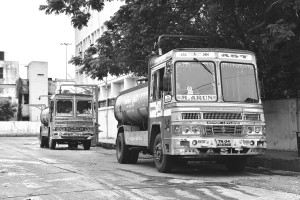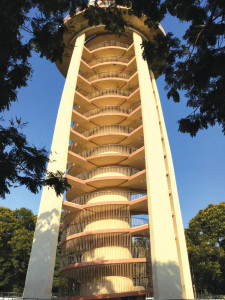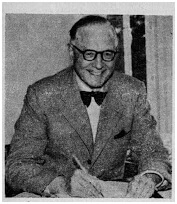Registered with the Registrar of Newspapers for India under R.N.I 53640/91
Vol. XXIX No. 1, April 16-30, 2019
Archives: Vol. XXIX No. 1, April 16-30, 2019
Water recycling – the need of the hour
by The Editor
 Water tankers – a familiar sight in the City. (Photo: S. Raja Pandiyan.)
Water tankers – a familiar sight in the City. (Photo: S. Raja Pandiyan.)
And so the long-anticipated water crisis has come. The Chennai Water Supply and Sewerage Board (CMWSSB) is still sending the precious liquid via pipes but this may not be for long. Water tankers have reappeared, as have long queues of people waiting with plastic pots for their quota from these vehicles. With most of the city reservoirs touching rock bottom, the off take is now from abandoned quarries that have collected water.
The CMWSSB claims to be supplying 550 million litres every alternate day to the city, the actual demand being 850 million litres per day. Keeping up even with this level of supply may not be possible for long. Cynics have it that it will cease as soon as Chennai votes – on April 18th. The areas outside the purview of the CMWSSB’s piped water, and these include the entire IT corridor, are not much better off. They have relied on tankers supplying water extracted from the mofussil and with resources depleting there as well, the crisis can only deepen. Meteorological statistics have it that Chennai and its surroundings received 54 per cent less rain last year and we are now facing the consequences.
We earlier tackled such crises by the Telugu Ganga project, the Veeranam scheme, installing desalination plants (a high energy and therefore expensive solution) and rainwater harvesting. The last named was perhaps the first instance of Chennai showing some responsibility when it came to conserving water. Here again, reliable sources have it that the first wave of the scheme, initiated in 2001 by the then Chief Minister, was the only effective one and all measures adopted by buildings subsequently have been mere shams. Whatever be the truth in that, it cannot be denied that Chennai did make a success of conserving rainwater. But happens when it does not rain at all?
Contract Farming — to make farm sector profitable
by A Special Correspondent
The passing of the Bill by the Tamil Nadu Government to promote contract farming is welcome news. Although the concept is not new there has not been enough serious effort to promote it especially for horticulture and cash crops that languish under conditions of price volatility and market uncertainty. The government web-site cites just eight projects under contract farming, indicative of the unexplored potential.
Lost Landmarks of Chennai
-by Sriram V

Tower, Annanagar
Chennai’s First Trade Centre
I owe a big thank you to Tripurasundari Sevvel for having led me to locate a lost landmark that I had been searching for, for several years. In terms of heritage it may not be all that old, just about 51 years or so. But to me it brought back precious memories of an outing in childhood.
The X-ray man at Madras
by Manmadhan Ullathil – from Maddy’s Ramblings

Dr. Christian Barnard.
Perhaps Dr. Christian Barnard’s blazing trail with his work on open heart surgery during the late 60s eclipsed the valuable contributions of another, the Captain Thomas William Barnard (TWB), O.B.E., F.H.A., F.R.P.S., M.S.R. who refined X-Ray techniques some three decades earlier, during his tenure at Madras. That he made a world standard institution of it at Madras would not be known to many and so I thought it a good idea to share some of TWB’s experiences and his charming insights with you all.
The Subbanna Reddy murder case
by C.K.N. Panicker, Deputy Superintendent of Police, Salem Town
Some famous crimes recorded in various Tamil Nadu police journals.
In the investigation of cases apparently trifling clues may lead to detection. It is therefore necessary to carry out a very careful examination of the scene of offense to discover such clues. The Subbana murder case reported below, in the investigation of which I had the good fortune to be associated, will clearly prove what has been said.
Early in the morning of March 25th, 1931, one Neelamegham, a key watchman of the South Indian Railway, while proceeding along the line from Srirangam to Bikshandar Koil Station, saw the dead body of a man lying in the Coleoon river-bed below the railway girder bridge. He proceeded to Bikshandar Koil Station and informed the Station-Master of what he had seen. The latter telegraphed to the Permanent-Way Inspector at Lalgudi. The Inspector took the next train to Bikshandar Koil and inspected the body. The deceased had not met his death as a result of any stab wounds in the neck and chest. Mr. Rangachari, the Permanent-Way Inspector, reported the discovery to the Police Out-post at Coleroon toll-gate and the Head Constable-in-charge passed on the information to Sub-Inspector of Police, Manachanellur and also to Srirangam Station, where I was then a probationer.

